Daniel Rothbart at Pockenpuetzchen
Daniel Rothbart at Pockenpuetzchen: Monday, October 29, 2012, 10:00 a.m. in a backyard in Aachen, Germany, 9° C.

This is a part of the city where twelve hot springs still exist, partly used in public baths, partly covered by steel lids in the streets. Four of them, framed in brick cube-like structures, protrude in a deserted place backed by a forty-foot-high extended stone wall that has been built upon since the Middle Ages – a perfect theatre stage. They are called Pockenpuetzchen (small pox wells); the name like others suggests diseases, which their water was assumed to heal – thousand-year-old water saturated with minerals pushing up from ten thousand feet, boiling in the depths and still a hot fifty degrees centigrade at the surface.
This morning the wells are surrounded by a dozen aluminum vessel sculptures filled with blocks of dry ice and three ten-foot-long “chains” loosely distributed and tied to knotted ropes. The links of these chains, fascinating new sculptural “rhizomes” by Rothbart – are cages (wax patterns cast in aluminum) embracing old blue and green glass spheres that have found their way from Japanese fishing nets to the Pacific coast of Oregon. They are conceived as vertical hanging structures with root-like “feet”, big cages housing up to eight glass balls.
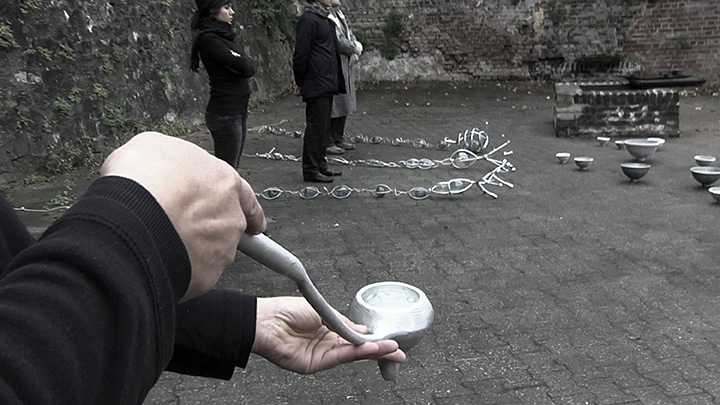
The stage set still life of the closed wells and the “snakes” surrounding them provoke expectations. Will the “snakes” dive into the hot springs when they are opened? (As Rothbart grew up in a family of psychologists, he might transform the image into a metaphor: what will happen when the Pandora’s box of the subconscious is opened and the fishing line of the ratio draws it to the clear light?).
At 10:00 a.m. workers open the wells. “Everything Flows, Nothing Stands Still (for Enrico Pedrini)” – the performance begins.
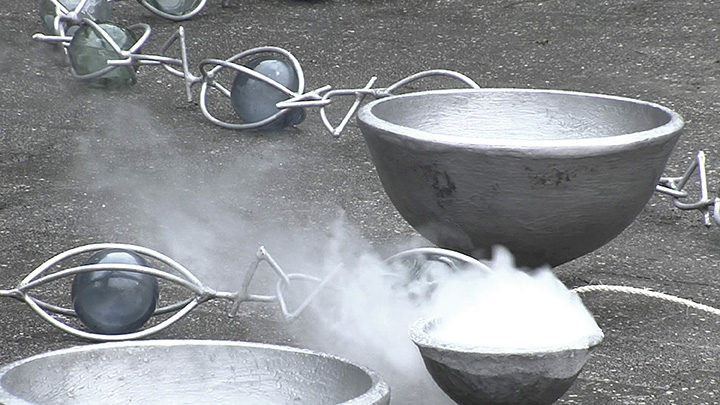
Daniel Rothbart as the “middle aged man” is accompanied by an “attendant”, the actress Annette Schmidt, a “young woman” Laura Moreno Bruna, a Spanish art student, an “old man” Ahmed Kreusch, artist and German Muslim (who was happy to perform with a Jewish artist from New York) and the camera team of Joachim Gerich.
The attendant moves slowly – priestess-like – ladling hot water into two vessels. They emit clouds of steam like incense. She takes up one of the long chains, carries it on outstretched arms over her head, walks graciously to the well and slowly lowers the sculpture into the shaft. It touches the water surface, diving and moving slowly in the narrow basin. She invites the young woman to pull the sculpture up and lay it on the ground in an irregular relation to the others.
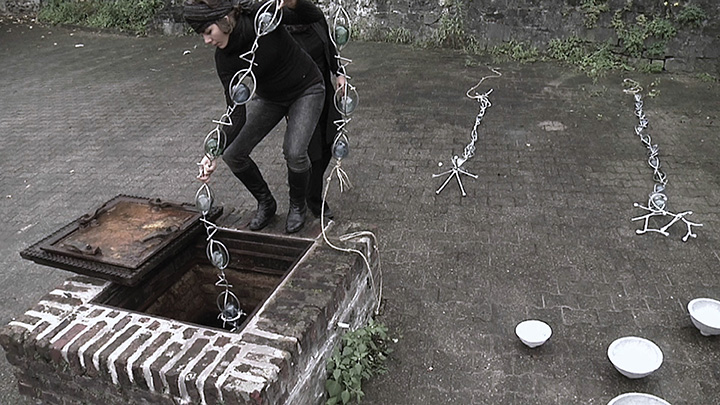
The attendant takes the ladle (which is another aluminum sculpture by Rothbart, itself with a strong ceremonial suggestion) and pours hot water into other vessels, producing more steam, accentuating the numinosum of the celebration. Now she takes the second sculpture and lowers it into the well. This time she invites the man in middle age to pull it out and place it differently. Finally, the old man pulls the sculpture up, holding the dripping chain triumphantly over his head and putting it down. The three chains are now arranged in another pattern than before.
The ceremony took fifteen minutes; and to show that it was invented to be repeated it is performed a second time at the neighboring well.
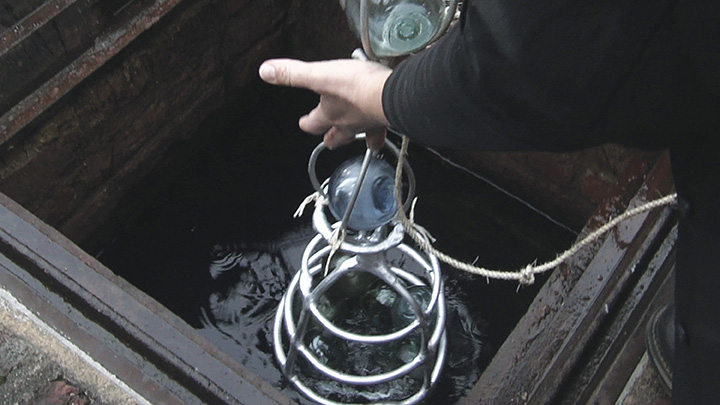
The performers did not know each other before, and the assistants were ignorant of Rothbart’s work. But they did not hesitate to take part: the extravagance of a New York artist in a deserted place in Aachen, hidden hot springs opened – the invitation was intriguing.
The performance did not demand extravagant gestures. The actors were silent and moved slowly recognizing the character and weight of the sculptures. Rothbart had wished the attendant to appear in black like a Japanese Bunraku puppeteer. This detail indicated the ceremonial theatricality of the action.
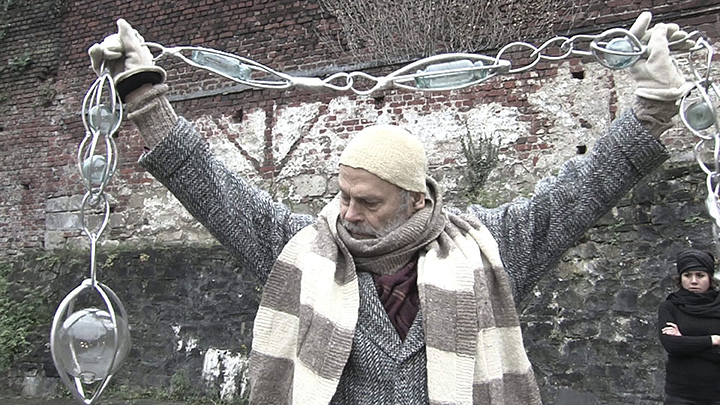
The dominant spectators of the performance were three cameras. They saw more than the visitors present and the performers as one of them dived underwater with the chains.
The underwater shots, in contrast to the slow-motion ceremony on the ground, show a lively and sounding encounter of the aluminum chains, the hollow glass spheres, the stones of the shaft and the saturated water. They suggest a microcosmic playful meeting of the DNA double helix chains and the clusters of hydrogen molecules, the ones closely knit together, the others uniting for fragments of seconds.
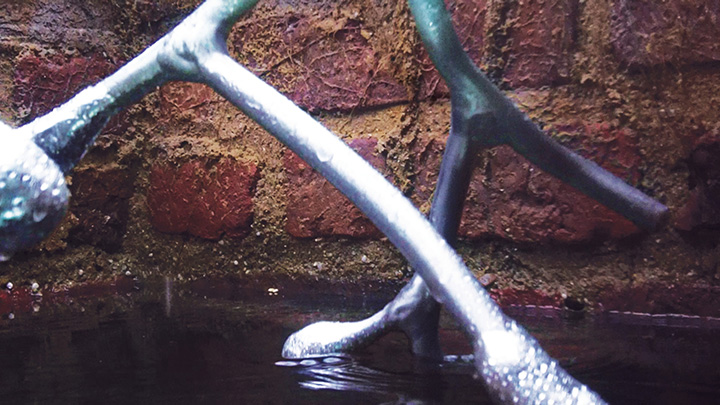
Many sources of “living” water are visited around the world; some are related to the history of Saints, others are renowned for their healing power. All of them reflect man´s need for clear and healthy water.
The water of the Pockenpuetzchen as of other springs in Aachen is one of the veterans of all sources – at an age of about twenty thousand years (full of memories, as some scientists believe), each kilogram of it contains four and a half grams of minerals: sodium, chloride, fluorine, arsenic – a “heavy” water – and it is hot. When the Romans found this northern valley steaming they settled down and built a spa.

The New Yorker Daniel Rothbart has entered this two-thousand-year-old area with a timid, but tenacious attitude of appropriation. These chains in patterns of twigs and vegetative proliferations embracing colorful glass balls, swimming once in fish nets of the Pacific Ocean, put down now into deep holes of the European continent, touching the arteries of the globe and bringing up its juice – the conception of a site-specific performance has been so happily realized because he came from afar and met an ideogram which he had not imagined before.
Wolfgang Becker
Aachen, Germany
Written shortly after the performance